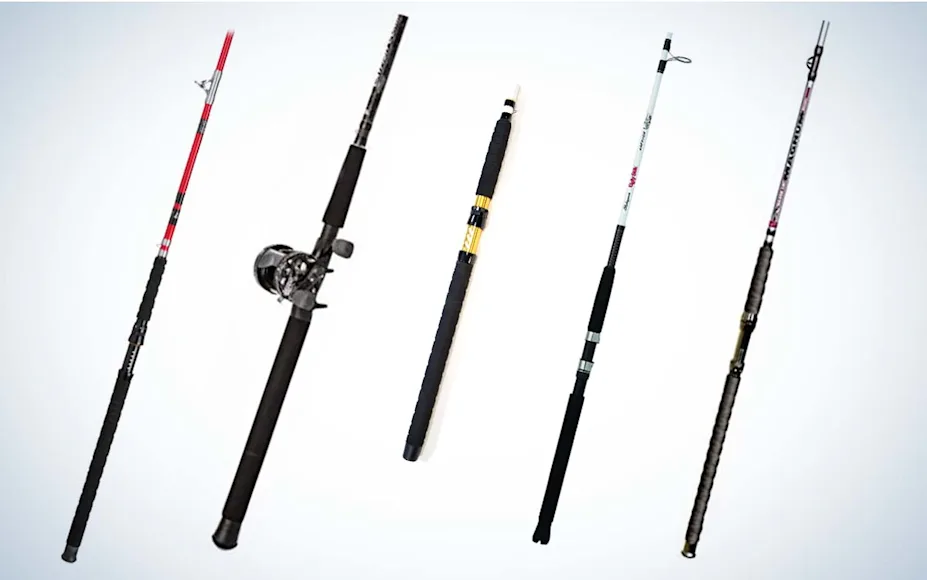_We may earn revenue from the products available on this page and participate in affiliate programs. Learn more ›
_
Best for Beginners

Bass Pro Shops King Kat
Best Graphite
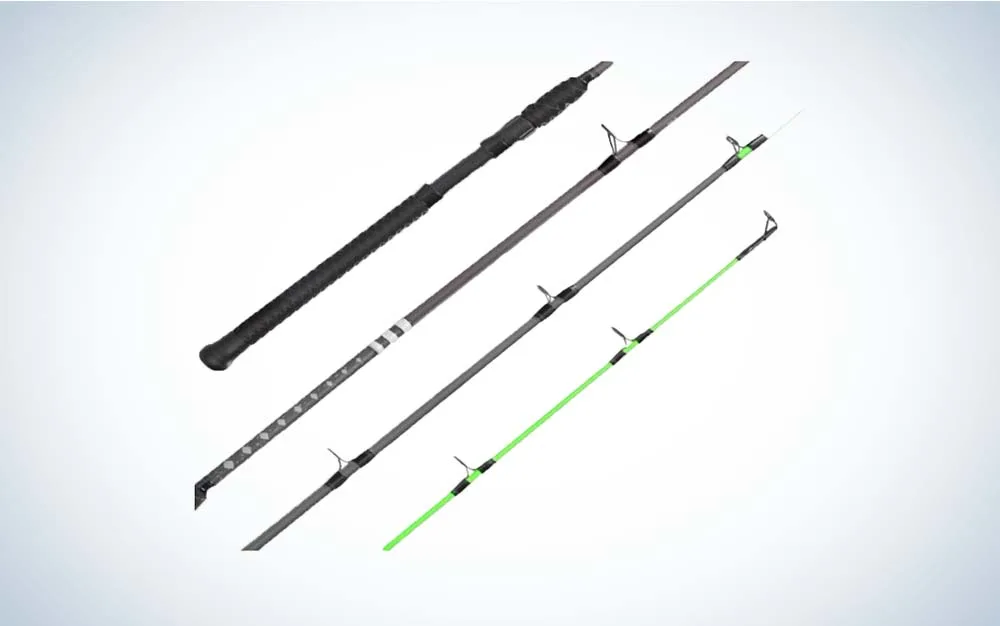
KastKing Kong
Best Composite
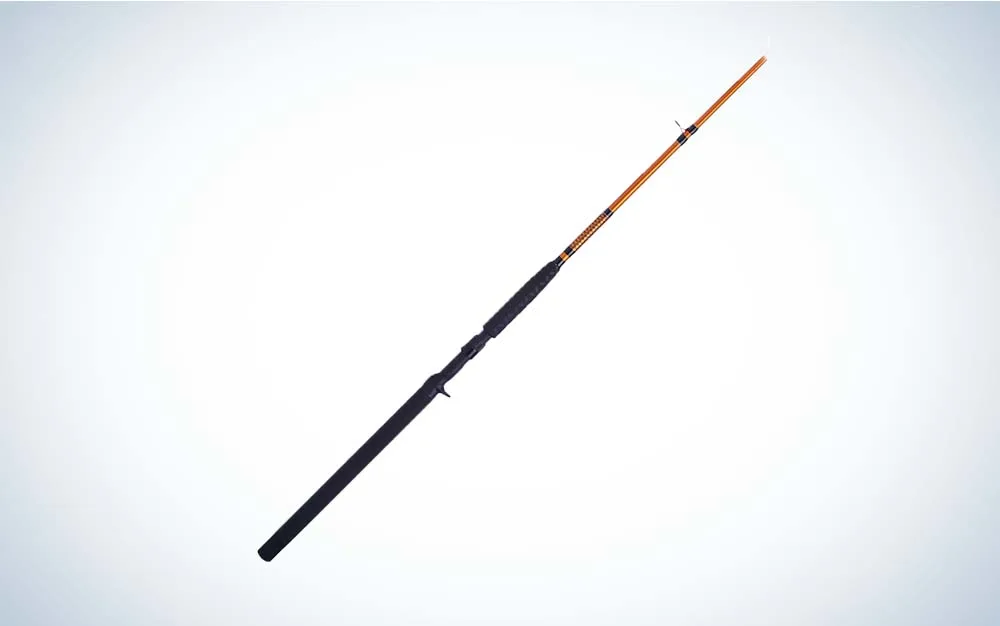
Ugly Stik Catfish Special
Catfish rods must be built to handle a list of tough tasks. They are flexible, lobbing casts that ensure large pieces of live or cut catfish bait
remain rigged. They are sensitive, detecting the slightest take and deciphering it from the batting action of the current. And they are powerful, solidly setting hooks in deep water and wrestling beasts to your boat or the bank. Finding the ones that bring all of those functions to the table starts with an understanding of their form.
The materials that comprise a blank define its rod’s on-the-water characteristics—from how it flexes to how much of a load it can handle. They’re further shaped by the rod’s length and components, including line guides and the handle. The right mix of those creates the best catfish rods.
Best for Beginners: Bass Pro Shops King Kat
Best Rod and Reel Combo: Abu Garcia Commando Casting Combo
Best for Bank Fishing: B’n’M Silver Cat Elite
Best Graphite: KastKing Kong
Best Composite: Ugly Stik Catfish Special
Best Carbon Fiber: Whisker Seeker FMJ
How We Picked the Best Catfish Rods
Pursuing large freshwater fish—whether bass, muskies, or catfish—requires anglers and their equipment to be at their best. I’ve spent decades fishing up and down the East Coast. Through that time, I’ve developed a perspective of what constitutes the best fishing equipment. But I focused on rods specifically designed for catching catfish while assembling this list of the best. And I asked four important questions of each.
Durability: What can it withstand? Catfish fishing is a contact sport, even when your line isn’t in the water. The best catfish rods stand up to abuse. Will it keep casting after being dropped on rocks or the deck of the boat?
Power: Can it tame big catfish? Built to bulldoze along the bottom, catfish are powerful fighters. The best rods apply enough pressure to steer them away from line-snapping cover and toward you. Power is borne from the blank and the rod should be medium-heavy or heavy. Longer handles create more power and leverage.
Action: The action of a rod describes how a rod flexes over its length and this goes a long way to determine its performance. Heavy weights and large hunks of live or cut bait—important pieces to catching catfish—require lob casts. They increase accuracy, reduce splash down and ensure bait isn’t cast off its hook. So, the best catfish rods sport a fast to moderate action, which bends no more than half of the blank.
Components: Is it easy and efficient to use? At their essence, the best rods are tools that help you catch more and bigger catfish. Handles must provide a firm grip. Line guides need to be durable and contribute to casting distance. Strike indicators, such as colored tips, help you see subtle takes. Hook keepers are also vital. They keep rigs at the ready, so you spend your time keeping up with changing conditions and catfish, not chasing tangles.
The Best Catfish Rods: Reviews & Recommendations
Best for Beginners: Bass Pro Shops King Kat
Best Overall

Specs
Length: 8 feet
Action and Power: Fast and medium heavy
Line and Lure Ranges: 10- to 25-pound test and 1 to 4 ounces
Pros
Spinning configuration is easy to cast
Built from strong and durable fiberglass
Length increases casting distance
Two-piece construction makes it easy to transport
Cons
Action may feel slower than similarly labeled rods
Quality of components slightly lacking
From tip to butt, this rod maximizes catching and minimizes calamities. The tubular fiberglass blank is finished in high-visibility white, making it easy to detect light bites. Double-footed guides, outfitted with friction free aluminum-oxide inserts help its 8-foot length cast baits further, an important part of covering water while shore fishing. The graphite seat is outfitted with stainless-steel hoods to keep the reel secure. This allows anglers to concentrate on landing big catfish instead of being distracted by equipment failure.
Built for beginners, this rod easily handles typical channel catfish, which weigh from 2 to 6 pounds. But don’t discount the rod for bigger catfish either. While there’s enough backbone to handle that chore, it isn’t prepared for heavier flatheads and blues. However, the wide range of lure and line weights adds versatility, allowing new anglers to try a variety of approaches without purchasing specialized equipment. And its two-piece construction makes it easy to carry inside a vehicle or along a brush-lined riverbank.
While its price ($29.99) is attractive, especially to beginning anglers with limited budgets, you do get what you pay for. So, it will feel heavier and less sensitive than more expensive rods with a similar length, action, and power.
Best Rod and Reel Combo: Abu Garcia Commando Casting Combo
Best Rod and Reel Combo

Specs
Length: 7’
Action: Moderate
Power: Medium heavy
Line and Lure Ranges: 10 to 30-pound test, and 1 to 3 ounces
Pros
Strong fiberglass and graphite blend
Stainless steel guides are tough and won’t corrode
Single piece rod has solid backbone
Cons
Only one size available
Ugly Stik makes some extremely sensitive rods. And when you pair them with an Abu Garcia reel, it’s an excellent combination for cranking in the big cats. The backbone on this rod is excellent thanks to the one-piece graphite and fiberglass construction. At the same time, the graphite also helps ensure good sensitivity for lighter bites. Ugly Stik uses good components with their rods, and the stainless steel guides here won’t rust or corrode, even when used in less than ideal weather conditions.
Our only complaint is that there’s only one size and power available. It would have been nice to have a heavy power with a higher line rating for larger fish. Thus, this size feels a little better suited for channel cats and smaller blues and flatheads. The $120 price tag might be a little intimidating to newer anglers, but this is a solid catfishing rig. Especially for an angler who’s never targeted them before.
Best for Bank Fishing: B’n’M Silver Cat Elite
Best for Bank Fishing
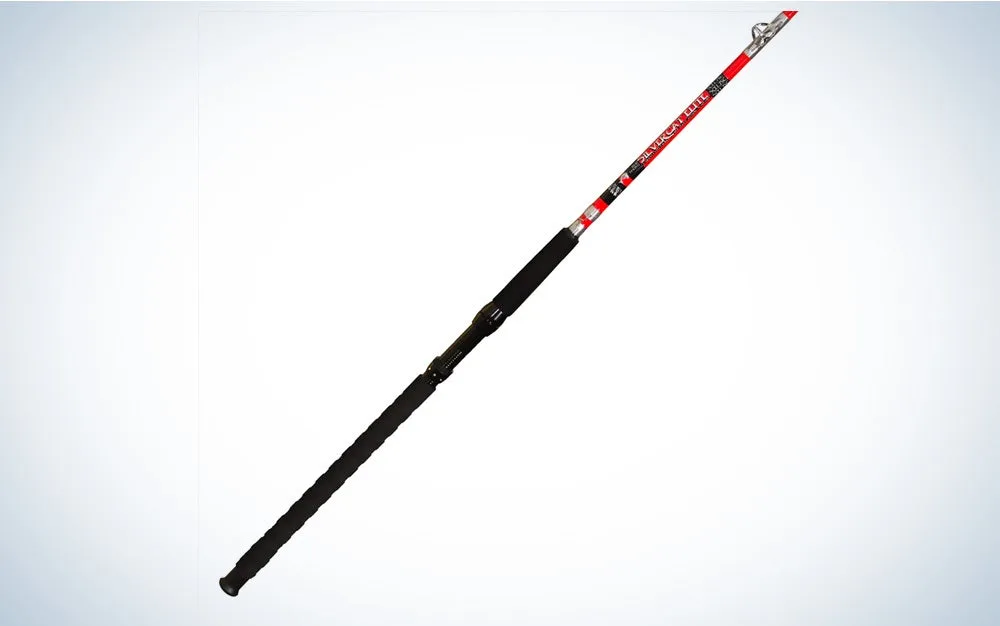
Specs
Length: 7.5”
Action: Fast
Power: Light, Medium, Heavy
Line and Lure Ranges: 25 to 60 Pounds, and 2 to 16 Ounces
Pros
Great components give it a rugged quality
Multiple lengths and powers available
Excellent backbone
Cons
Expensive for a bank rod
The Silver Cat series has quickly become a favorite among catfish anglers nationwide. And for good reason because they have a reputation for being unwieldly tough thanks to an E-glass blank construction. B’n’M went with some excellent components here including a lightweight aluminum reel seat and stainless steel guides. But it’s built for the dirt, mud, and grime along the riverbank. As a bonus, there’s a large range of line weights and lure weight capabilities for this line. There’s even a light version for the targeting of smaller cats, or just for anglers who like a challenge.
While these rods are a bit expensive, they are great for anglers tired of busting cheaper options consistently on the riverbank. B’n’M also offers them in both casting and spinning models. Thus, anglers are covered on options no matter your preference of reel.
Best Graphite: KastKing Kong
Best Graphite

Specs
Length: 8 feet
Action: Fast
Power: Very heavy
Line and Lure Ranges: 40 to 80-pound test and 6 to 16 ounces
Pros
Lightweight construction makes it easy to fish all day
Easily tackles tough conditions, heavy lures, and big catfish
Quality components include nine line guides and graphite reel seat
Cons
Doesn’t handle light lures and line well
This isn’t your typical catfish pole. It is a solid, graphite blank held together with nano resin. This cuts weight while increasing strength and sensitivity. Its nimble feel leads to more accurate casts, whether you’re pitching rigs to laydowns in a murky river or casting to a piece of structure in a giant reservoir.
Backing up its construction are a bevy of tough components. Its double-footed stainless steel guides have aluminum oxide inserts, which stand up to heavy line and lengthen casts. A reinforced graphite seat keeps baitcasting reels locked onto a comfortable foam handle that has rubber cross wraps for durability and finger slots on the foregrip for added control. Watch its chartreuse tip, which makes seeing any bite easy, especially at night or on overcast days.
With as much as this rod has to offer, it does have its limitation. Kast King designed this rod for chasing catfish on big waters. Subsequently, it’ll only handle the matching heavy lines and lures. That makes it more of a specialized piece.
Best Composite: Ugly Stik Catfish Special
Best Composite

Specs
Length: 9 feet
Action: Moderate
Power: Medium heavy
Line and Lure Ranges: 15- to 40-pound test and 1 to 4 ounces
Pros
Two-piece construction makes transporting it easy
Extra length extends casting distance and control
Moderate action provides a soft touch for lobbing bait
Cons
Only handles light lines and baits
9-foot length may require an adjustment period
Trading the traditional Ugly Stik black for orange, this Catfish Special is built for bank angling. Although it will work fine from a boat too. Its 9-foot length and moderate action create out-of-sight casts, allowing you to cover more water. Additionally, the medium-heavy power is great for any type of catfish. And there’s plenty of trademark Ugly Stik toughness in its two-piece construction, so you don’t have to worry about durability.
The secret is in its blank, whose blend of graphite and fiberglass maximizes toughness, sensitivity, and power. More toughness is found in its clear solid tip and one-piece stainless-steel line guides. Its handle features shrink-wrapped rubber, ensuring a secure grip no matter how much catfish slime is on your hands.
But it does take some time to get accustomed to the 9-foot length. You’ll need more room behind you for back casts, and small tip movements will move your bait the same distance as bigger ones with shorter rods. Finally, be cognizant of the limitations of lure and line weights. However, this rod is great for catfish that can weigh up to 25 pounds. It’s ideal in water that’s 30 feet or shallower with little to no current.
Best Carbon Fiber: Whisker Seeker FMJ
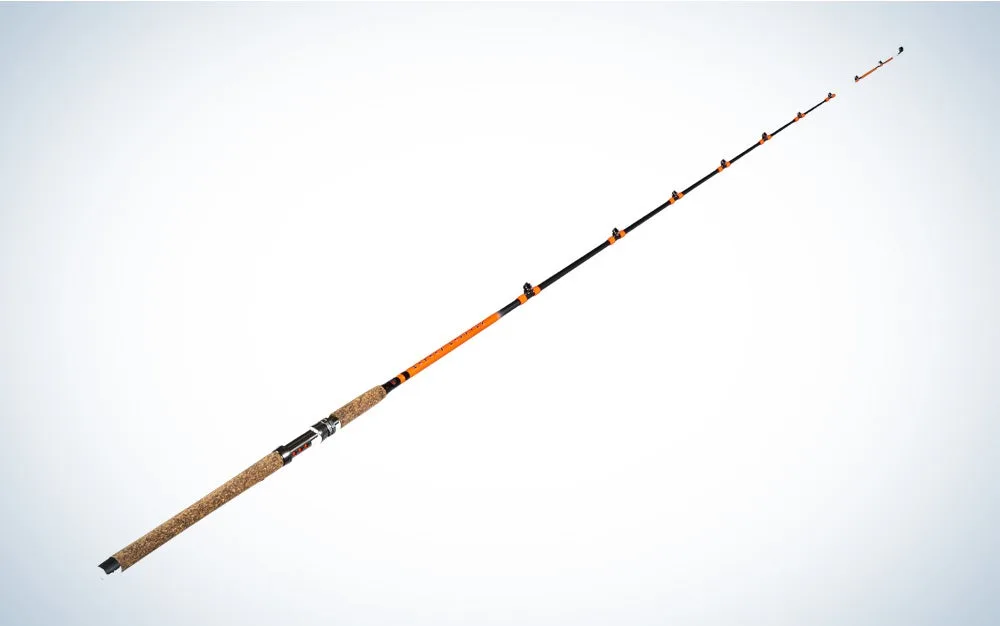
Specs
Length: 7 feet, 6 inches
Action: Fast
Power: Heavy
Line and Lure Ranges: 10- to 50-pound test and 1 to 12 ounces
Pros
Carbon fiber brings power and strength
Handles a wide range of line and lure weights
Cons
Action may feel slightly slower than other similarly labeled rods
This Whisker Seeker FMJ’s uniqueness comes from the space-age materials that comprise its blank. They include two layers of non-woven unidirectional carbon fiber, which is responsible for the rod’s structure, backbone, and power. A layer of nano-fiber mesh in between reinforces its action and power. All work in unison to create a perfect balance of leverage, casting distance, and versatility while being light enough to fish all day.
Its 10 stainless steel one-piece guides are durable and contribute to casting distance, whether you’re using monofilament or braided line. An aluminum seat keeps reels securely attached, and a long handle provides comfort and leverage. The no-slip composite material is ideal for this rod. It may resembles traditional cork but it offers more far more durability.
While this rod packs plenty of power, it lacks in some spots. Its action may feel slower than a true fast, allowing it to flex further down the blank. And its lightweight belies its strength and power. So, you’ll need some time to get comfortable fishing it. But as you push it, you’ll quickly become a believer.
What to Consider When Choosing a Catfish Rod
Catfish can reach gigantic proportions. The world record flathead weighed 123 pounds and came from Santee Cooper lake in South Carolina. So, it’s a no-brainer that a catfish rod must be powerful. But there’s more to their story, including these other important characteristics and considerations.
Target Species
While catching a mess of channel catfish and hunting for a giant blue catfish that can weigh upward of 100 pounds require completely different approaches—starting with the gear that you’ll need. So, consider the size of the catfish, where it lives, and what it eats when selecting a rod. The medium-heavy power spinning rod that will make quick work of a channel catfish in the local pond, for example, won’t stand a chance against a blue or flathead. You’ll need a winch-like baitcasting outfit for those.
Length
Long rods can feel unwieldy at first, but you’ll quickly learn to appreciate the leverage they provide. They pack as much power as a short stout rod but create more control, whether while battling a big catfish or increasing casting distance. They also don’t tire you out as quickly. Remember length is relative. While bank anglers will appreciate the added casting distance created by a 9-foot rod compared to a 7-foot rod, a boat angler dropping cut-bait rigs over the gunnel will see benefits by switching to a 7-foot rod from a traditional 6-foot one.
Action, Power, and Components
Action and power describe a rod’s performance. Fast-action rods, for example, flex only in their tip, and-heavy power rods handle big baits and strong line. Both work independently, so it’s important to identify the right mix. A heavy-power rod, for example, would be overkill if you want some small channel cats for dinner. You’d be better off with a medium power, which would perform better with smaller baits. Additionally, consider a rod’s components, too. Stainless steel line guides, beefy cork or composite handles, and rock-solid reel seats increase performance and longevity. Catfish rods take a beating from big fish and heavy sinkers. You want something that will last.
Material
Modern fishing rods are constructed with fiberglass or graphite. Fiberglass, for example, is durable but flexes from tip to handle. Graphite, on the other hand, creates sensitive rods that feature fast actions, flexing only at the tip. Some rods blend the two materials, seizing each’s best attributes.
FAQs
Q: What line size should I use for catfish?
Match the size of the line you use for catfish to how, where, and what you’re fishing. Channel catfish, for example, usually run less than 10 pounds and swim in relatively snag-free waters, so 10- to 12-pound test line is perfect. But if you’re after big blues, which routinely weigh 50 or more pounds, or flatheads, which prefer tangles of sunken timber, then you’ll need 80- to 100-pound test line. Use a line within the range listed on the rod. Monofilament and braided lines are among the best lines for catfish
. Monofilament is strong and inexpensive, while braided line packs more strength in less diameter, making it easy to cast heavy lines. Both are available in a variety of colors, including fluorescent. It glows under a black light, making it easy to see bites when fishing at night, a productive time to chase catfish.
Q: What weights should I use for catfish fishing?
It depends on the scenario. Split shot weights from 1/8 to 3/8 ounce, are often used for fishing in shallow water and under slip floats. Because split shots are easy to use, they can be used to fine tune the amount of weight for the area being fished. Switch to egg or walking sinkers, which can weigh upwards of 16 ounces, when targeting large catfish swimming in current or deep water. They slide onto your line, allowing catfish to eat and move with your offering without feeling the resistance of the weight.
Q: What bait should I use for catfish to get the best results?
The bait that gets the best results for catfish depends on which of the three species— channel, blue, or flathead—that you are pursuing. Channel catfish, which are the most numerous and run the smallest, bite a number of baits, including nightcrawlers, balls of cheese, and hot dogs marinated in Kool-Aid. They’re suckers for stink bait, too. Sometimes called dip or punch bait, the noxious concoction can be found as nuggets but usually is in a paste form. These baits are wiped or applied to a hooked device. They slowly release scent, attracting catfish. Flathead and blue catfish prefer meat. While some anglers swear by chicken thighs, baitfish like shad, herring, and bream, are more popular. Flatheads prefer live meals. Blues will eat live bait, too, but cut portions of fresh or frozen fish work equally well.
Best Catfish Rods: Final Thoughts
Best for Beginners: Bass Pro Shops King Kat
Best Rod and Reel Combo: Abu Garcia Commando Casting Combo
Best for Bank Fishing: B’n’M Silver Cat Elite
Best Graphite: KastKing Kong
Best Composite: Ugly Stik Catfish Special
Best Carbon Fiber: Whisker Seeker FMJ
Today’s catfish anglers fish a host of situations and rely on a variety of techniques. Thus, the greater demand rods that are sensitive, powerful, and durable. The best catfish rods are ones that have all those traits, regardless of manufacturer and price point.
Why trust us
For more than 125 years, Field & Stream has been providing readers with honest and authentic coverage of outdoor gear. Our writers and editors eat, sleep, and breathe the outdoors, and that passion comes through in our product reviews. You can count on F&S to keep you up to date on the best new gear. And when we write about a product—whether it’s a bass lure or a backpack—we cover the good and the bad, so you know exactly what to expect before you decide to make a purchase.

